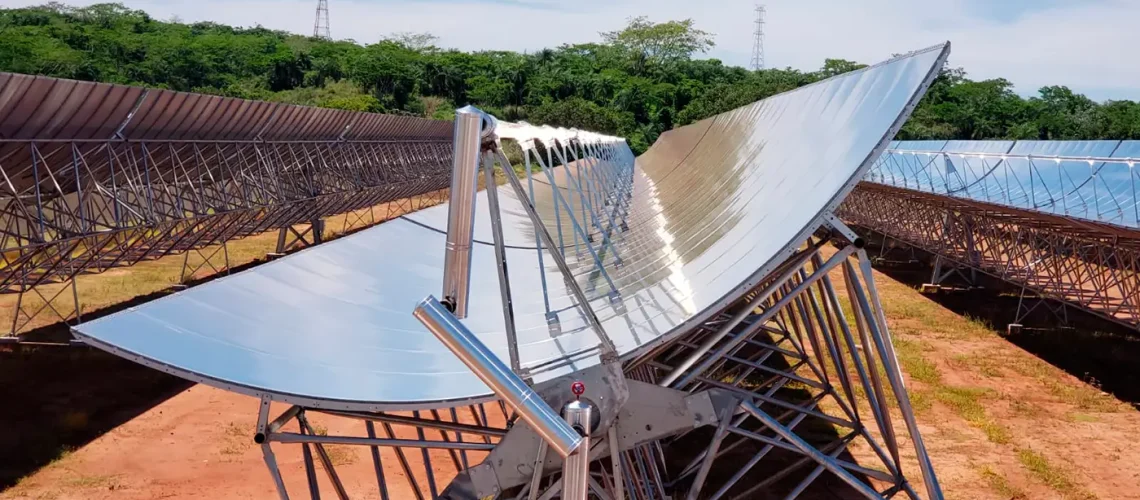Source: www.klinger-international.com/
KVN piston globe valves support a large heliothermal power plant in Rosana, São Paulo.
A new chance for KLINGER Brazil to contribute to a green energy project recently came about in Rosana, São Paulo, where Eudora Energia just completed the nation’s first heliothermal power plant. Heliothermal energy, also known as concentrated solar power or CSP, converts solar energy into heat through the use of parabolic mirrors and thermal fluid.
The sunrays are reflected and concentrated by the mirrors into a single point, which heats the thermal fluid and produces steam via heat exchange. This steam drives turbines, which run a generator and produce electricity. Eudora Energia, a specialist in energy solutions, started to develop this technology in 2015.
When Eudora was designing the plant project, the team conducted research on the valve market to learn their options for fluid control. Once the exact specifications were finalized, they realized the choices were limited: few companies were capable of producing valves that met the stringent requirements necessary for controlling thermal fluid with the precision needed for the project. Their search led them to KLINGER, who had proven history with the medium.
“Eudora did technical research on the success we have had for over 20 years in using our valves in applications with thermal oil. This was a great motivator for installation in the project.” Rodrigo Rígolo, Sales Executive for KLINGER Brazil.
High water tightness and reliability
After conferring in detail with Lucas Hipolito, Project Analyst at KLINGER Brazil, Eudora decided on KVN piston globe valves, which feature class VI sealing per ANSI/FCI standards, guaranteeing a high level of water tightness and reliability. The high durability of the valves leads to less frequent servicing and fewer replacement parts. This reduces waste and avoids fugitive emissions, which helps to keep the project as eco-friendly as possible. Another key feature was the valves’ ability to fine tune the flow levels, giving the team the ability to make granular adjustments as needed without taking the system out of service.
After valve installation was underway, the value of KLINGER continued to pay off for Eudora through expert and readily available technical support, which allowed the team to set the valves with even higher levels of precision than originally expected.
“The benefits of the valve presented were even better than the initial project required. We had in our hands a large and innovative work, with no chance of error. We opted for KLINGER valves, as we needed to install the safest on the market.” Alessandro Sete, who is the Project Manager at Eudora is enthusiastic about the benefits of the valves which even exceeded the requirements. © Alessandro Sete/Eudora Energia
After nearly a year of problem free operation, it becomes clear: the Eudora plant is fueled by the power of the sun, but KVN piston globe valves are truly the shining star of the project.
Faktenbox
Facts and figures
When Eudora Energia’s solar thermal power plant in São Paulo began operations at the end of January 2022, it was the first project of its kind in Brazil. R$ 49 million was invested in it, and the design work had been underway since 2017. Since its completion, the plant has been producing 0.5 megawatts of electricity to supply the surrounding area. The tank, where the heat can be stored overnight, is almost 23 meters high.
Frequently asked questions (FAQ)
What is CSP?
CSP stands for ‘concentrated solar power’ and describes a method of harvesting the energy of the sun. While photovoltaic systems only produce electricity during the day, CSP-plants can store the sun’s energy to also use it at night, thus increasing energy efficiency.
How can CSP be used?
The primary output of CSP-plants is solar thermal energy. This heat can be used for industrial processes, powering a steam turbine or the production of electricity with an electrical power generator.
What is the operating temperature of CSP?
At plants using the parabolic trough technology, temperature levels range from 150–350 °C (302–662 °F). Solar power towers, which concentrate the sunlight in a single point, reach up to 500–1000 °C (932–1,832 °F).

